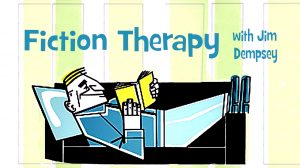Posts by Jim Dempsey
After seeing lots of hype in the media, I’ve been catching up with the HBO series Succession. The writers are there are expert at manipulating their audience. Their basic message is straightforward and not subtle.
The main characters – members of a family that owns a multinational media and entertainment empire – are horrible, selfish and self-absorbed. They treat everyone with contempt. But they reserve their true disdain for those outside the immediate family, in other words, those who are not super-rich.
Cousin Greg arrives bright-eyed and eager, desperate to ingratiate himself into the business. He meets Tom, who is also an outsider after marrying into the family. We’ve already seen Tom crave the attention of the patriarch, Logan, to the point of being sycophantic. And yet he still ends up the brunt of many insults as he struggles to fit in. Tom could be the perfect ally for Greg. And Tom appears helpful. On Greg’s first day, Tom tells him in a calm sympathetic tone, “If you need any help, seriously, any help, any advice … just, you know … don’t f***ing bother.”
Read MoreThere’s a lot of writing advice that tells you to find your characters’ goals. If you can work out what drives them in their lives, you can use those goals to drive the story.
Most of this advice will tell that your character should have two goals: internal and external. The alcoholic detective’s external need is to find the killer while his internal need is to get over the loss of his wife, which is what drives him to drink. The young student at the school for magic needs to combat evil (external goal) while also trying to win the approval of her peers (internal goal).
Having both an internal and an external goal adds depth to your character. This is what makes them seem more real, more three-dimensional (as the textbooks say).
But characters’ goals change throughout the story. And they usually have many smaller goal to achieve on their way to the final battle. In Star Wars, for example, Luke Skywalker first wants to leave Tattooine, then he has to find Leia, then get off the Death Star, become a Jedi, and only then can he destroy the Death Star.
There is, however, one thing driving the character to meet all those goals, whether they’re internal or external. What really drives characters to achieve their goals are their values, their idea of what is most important in their life. The things that really matter to them. These never change throughout the story, regardless of the goals the characters pursue. Identifying your characters values will help you make sure your character is motivated throughout the story and acts consistently every time.
Read MoreYour phone rings. You check the screen. You don’t recognize the number. Do you answer it?
The cars in front of you on the highway slow down, their brake lights glowing. The traffic is gridlocked up ahead, but there’s an exit just before. Do you take it?
Life is full of decisions, apparently simple choices that could take you in a whole different direction. Fiction, as a reflection of life, is the same. In the hero’s journey – a template for stories found all over the world – there is what Joseph Campbell called the refusal of the call. This is the moment, early in the story, when the hero knows he has to do something to change his ordinary life, but doesn’t yet feel able to take that step. He refuses, and those around him try to convince him that he has to take that journey. Eventually, of course, he will because otherwise there would be no story.
In The Sound of Music, Maria doesn’t want to leave the convent, but Mother Abbess sends her to the von Trapp house anyway, believing it would be a more appropriate environment for Maria. Dorothy in The Wizard of Oz is different, she wants to leave, and Professor Marvel, the charlatan fortune teller, has to convince her to go back home.
These are big moments of decision in a story, when the main character has to decide whether or not to go on that journey, to cross the ‘first threshold’ into the second act. But the hero makes many more decisions throughout the journey, as do most other characters, and each one of those choices could have a profound effect on the course of the narrative.
Applied psychology
In psychology, this moment of decision is called a choice point. Therapists can try to make their patients aware of these moments to recognize the impact of certain choices. The technique can be used for anything from addiction to stress reduction. In anger management, for example, a subject could be aware of the moment where they could choose between flying off the handle or reacting differently, in a way that would ultimately have a better outcome on their life, in a way that they, perhaps later, would have preferred to have reacted. The idea is to encourage flexibility in their response to certain triggers.
The technique is also useful in stories.
Read MoreThe great thing about Writer Unboxed is the sense of community it gives to writers. There’s the twitter account to follow, the Facebook group to connect with others, and, of course, the unconference where you can really engage in all things writery. All of this is so important in the otherwise solitary task of writing.
Beyond WU are the many writers’ groups, often online these days to help writers connect with others working in their specific genres or interest areas. And then there are beta reader groups and review sites, all of which can provide essential constructive feedback as you progress on your writing journey.
Constructive feedback is the important phrase there. In a previous article, I described how to respond to criticism, but it’s also important for anyone in any writing community to know how to give that all important constructive criticism.
I have to do this all time in my story analysis work, and over the years I’ve gathered a few basic rules to follow.
Read MoreA father, Jim, takes his son thirteen-year-old son, Roy, to Alaska in the tradition of all those great male adventurers. It’s long been an ambition for Jim, to pack up and live off the land for a year. It gives him the chance to connect with his son and show the boy what it means to be a man.
But Jim doesn’t know this environment. When challenged, he makes mistakes, bad decisions and over-rules his son’s suggestions. After all, Roy is still a child. What does he know? Jim is the father; he should know best.
But he doesn’t.
Read MoreThere are times when writing is easy, when you get through that daily word count without too much effort. And there are times when the final goal – that moment when you can type The End – seems very far away. There will be days when you think it will be impossible to reach, and it seems so much easier to check Instagram, Facebook, Twitter or even clean the house.
When you get to that point, however, there’s a better way to procrastinate. Follow this quick and simple process to overcome your writing barriers.
Read MoreBest-selling thriller writer, Ian Rankin, has been writing professionally since the mid-1980s. He’s written close to 30 novels. He pretty much writes a book a year. But, at a certain point in his drafting process, usually somewhere at the end of the first month, he is struck by, what he calls, ‘the fear.’ He is convinced that all the work he’s done in that month has been a waste of time, that this new book won’t be any good.
When he mentions this to his wife, she usually asks, ‘Are you on page 65?’ He thinks about it, and yes, he is. It’s then he realizes that he goes through this phase with every novel, always at the same point. Always around page 65.
Many writers, if not all, experience this kind of doubt about their work at some stage. And, since writing is such a lonely profession, they don’t all have someone with whom they can share their frustrations.
I feel privileged, in my work as an editor, that authors confide their fears in me. Sometimes they just need someone who can give them feedback, someone with experience who can reassure them that their work is worth pursuing after all and they’re not wasting their time. Someone who can help them get past their page 65.
But not everyone has the time, the inclination, or, let’s face it, the money to seek reassurance from an editor. That doesn’t mean you have to suffer alone. Below are some techniques that can help authors deal with that inner critic and get back to writing.
Read MoreWorking out what your characters’ goals are will help you plan your plotline and develop engaging, motivated characters your readers will love to follow.
Your characters need goals to get them to the next page, and then the next, and on until the end. They need to be going somewhere, trying to achieve something. That will make them the kinds of characters readers will want to spend time with, maybe even for a few hundred pages.
Readers will want to know if your characters achieve those goals, and if they will overcome the inevitable obstacles (you put) in their way. Sometimes they will, sometimes they won’t. They will have small goals that they can achieve (or not) within a couple of pages, and they will have those overarching goals that will take your heroes right through to the end.
Even Oblomov, the man who stayed in bed for most of the story, had a goal: he wanted to stay in bed. And he worked hard to do it. That was pretty much his story.
Your characters’ goals are therefore essential for determining your plot. Work out the goals and you’ll go a long way to having a plot. And, if you already have a basic plot, you can develop it in greater detail by working out what your characters’ goals will be along the way.
Read MoreWhether you’re wondering what happens next in your story, want to write your first novel, or are about to start on the next instalment of your long-running series, there are always times when you’ll need inspiration. And it is often surprisingly close by.
‘Be observant,’ said the dramatist, Lajos Egri, ‘and you will be forced to admit that the world is an inexhaustible pastry shop and you are permitted to choose from the delicacies the tastiest bits for yourself.’
It’s that easy.
Except it’s not.
It’s difficult to suddenly ‘be observant.’ You don’t have time to sit around looking at things. You have to pick up the kids, get to the supermarket, make dinner, finish off that last game of solitaire. And you have to write!
Hemingway noted that it was difficult to be observant, but he also recognized its importance for writers. Being observant, he said in his 1935 Esquire article, Monologue to the Maestro, takes practice. ‘You should be able to go into a room and when you come out know everything that you saw there and not only that. If that room gave you any feeling you should know exactly what it was that gave you that feeling. Try that for practice.’
You don’t have to memorize every object in a room. There are simpler ways to get inspiration for your writing from observing the world around you. It can start with your morning shower.
Read MoreEvery month, I examine some aspect of fiction—character development, plot, story structure, etc.—and offer advice and tips to help you work through the problems in your novel.
I have adapted many of the concepts you’ll see here from proven techniques used in modern psychotherapy. Hence: Fiction Therapy.
If you have a specific concern about your novel, send an email to jim [at] thefictiontherapist.com and I’ll do my best to help.
I recently reviewed a debut novel, The Valley at the Centre of the World. In it, the author, Malachy Tallack, describes life in a rural village on the island of Shetland. And he tries to do that in an accurate and honest way.
The problem is that not a whole lot happens in a remote village. The inhabitants go about their daily, seasonal and yearly rhythm. Strangers might arrive, but they’re usually looking for peace and quiet. Others might leave, but villagers are used to that too as people, mostly the younger generation, go off to pursue opportunities in the city. Even deaths in these aging communities happen regularly enough that there’s a certain routine to them too.
When nothing happens, nothing changes. And novels—stories in general—are all about change. There is (nearly) always a moment of self-realization for the (usually) main character.
And yet Tallack makes his story work.
How?
Read MoreMy last article, on the pitfalls of self-editing, provoked some discussion about the different types of editing. There’s certainly a lot of confusion around, and it’s not surprising.
There’s line editing, copy-editing, developmental editing, structural editing, substantive editing, and then proofreading. Editors can hardly agree on exactly what’s involved in each type, and that’s because it can be difficult to draw definite lines between each one.
But authors, since they are often the ones paying for the service, need to be aware of what kind of editing their manuscripts need and what is involved in each type.
And it’s all not so complicated. There are really only three types of editing. Everything else is another name for the same thing or an overlap of two. Fortunately, there can be no confusion about proofreading, so let’s start there.
Read MoreLet’s get this out of the way right at the start. I’m an editor. I’m going to be biased, but I’ve seen this scenario so many times over the years.
As an author, you spend months, sometimes years, perfecting your novel, carefully considering each word, crafting every sentence, and polishing every paragraph.
When you’re finished you read through it only to find tons of typos and a multitude of grammatical blunders.
You edit as you go. You get rid of all those errors, and you rewrite and you rewrite. You sit at your computer and, to paraphrase Hemingway, you bleed. And you perfect.
You send your manuscript to some friends and beta readers, and they come back with a few issues and a few more spelling mistakes. And you edit and rewrite some more till you get your manuscript into the best shape you can possibly make it.
At this point, all the best advice says you should you send your manuscript to an editor. Let’s assume here that you do. And not just any editor. You’re diligent. You’ve searched the web, asked for recommendations, and found a well-qualified professional. Maybe you send a sample first. That’s always a good idea.
When the revision comes back, you read the body of the editor’s email first. It’s usually full of positive feedback and general encouragement. “Not too bad,” you think, “it could certainly have been worse.”
And then you open the document, and all you see is red—literally and figuratively.
Read More










